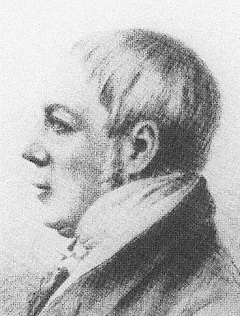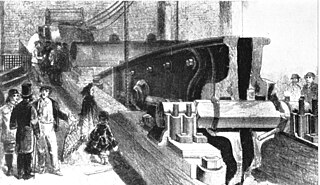Coal mines
From around 1750 Brown worked as a viewer - the man with the technical expertise to develop a colliery and then to deal with the geological and water problems inevitable in a mine. He was responsible for all the machinery, the waggonways and had to be a competent surveyor He was expected to provide financial advice to the owners and to recruit, manage and retain the workforce needed to operate the mine.
Like many viewers, Brown became a part owner of the collieries in which he worked. Besides Throckley Colliery, in which he owned a half share, Brown later had shares in both Shiremoor and its successor Willington, which were very successful and profitable enterprises.
Over the next 30 years through a combination of his mining skills, the installation of steam engines for pumping and the creation of waggonways to deliver coal to the Tyne for transport he developed a number of new mines and seams at Throckley, Heddon, Hartley, Shiremoor, Walbottle, Willington and Wallsend, though he died a few months before the latter opened.
He was one of those who helped win the High Main Seam, a six-foot seam of high quality household coal to the east of Newcastle which was at a much deeper level – around 600 feet - than the same seam to the west of the city and at one time had been thought unreachable because of the presence of water.
His work was not just with coal mines as he had involvement in Yorkshire with copper mines at Middleton Tyas, near Richmond and lead mines at Grassington and in Swaledale.
Brown was also concerned with technical developments within mines. There are claims that he was the first to introduce the screening of coals; he made attempts to mechanise the hewing process with a machine known as 'Willy Brown's Iron Man'; and he was senior viewer at Hartley Colliery when steam winding was introduced.
Waggonways
Waggonways – the early railways with horses and wooden rails usually used to transport coal from mines to docks – were important to mining development. They developed into complex networks, much like the iron railways of the nineteenth century; and, like these, they made possible a massive expansion of the coal industry.
It is not known where William Brown gained his experience in waggonway construction, though the likely place was the network of waggonways leading to the staiths at Stella on the opposite bank of the River Tyne to Throckley.
Brown was involved in planning and costing many developments, though the construction was done by contractors. He was particularly active in the Throckley area. The decision to make Throckley a seasale colliery – producing coal for shipment by sea, particularly to London - justified the building of its first railway, opened in 1751. The Wylam Way – an extension to this - was opened in 1756 and there were other additions as new pits opened in the Throckley and Walbottle area over the next few years. In 1758 a waggonway to his design opened a few miles north of the Tyne estuary from Hartley Colliery to the coast.
Later in his career he was to design the important network of waggonways east of Newcastle, and others south of the Tyne such as the line from Harraton to the River Wear, those from Washington Colliery to both the Tyne and the Wear, and that from Beamish to Fatfield. In 1776 he surveyed the route for a waggonway which followed the edge of the Newcastle Town Moor to the Tyne, but it was not built.
His work was not just limited to the North East - in 1754, he was commissioned by the Duke of Hamilton to provide a waggonway underground at Bo'ness Colliery near Edinburgh.
Steam engines
From about 1750 until his death in 1782 William Brown was primarily recognised as the builder of Newcomen steam engines for pumping purposes. He built engines at some 20 collieries in the Great Northern Coalfield in Northumberland and Durham, as well as in other parts of England, and in Scotland and Ireland. The first Boulton and Watt engine in the Northumberland and Durham coalfield was erected at Byker Colliery in 1778 to assist with pumping, almost certainly commissioned by Brown.
In this work he was associated with notable engineers of the eighteenth century, such as John Smeaton, James Brindley and Abraham Darby and his clients included dukes and earls as well as lesser gentry.
Brown was responsible for the introduction of larger iron cylinders, eventually as large as 75 inches in size (and 10 feet long) compared to the 42 inch cylinders in use in 1750, which made more powerful engines possible. He realised the need for a plentiful supply of steam and built multiple boilers to improve this. He also used larger pipes – the 24 inch wooden pipes for Benwell being three times the size commonly used.
He obtained materials for engines from a variety of suppliers. The brass cylinders of the early engines were probably produced locally; the larger iron cylinders used later were mainly built at Abraham Darby's foundry at Coalbrookdale. As Brown was closely associated with the Midlothian collieries in Scotland he would probably have had connections with the Carron Iron Works near Falkirk, and may have also acquired cylinders from there. The wrought iron plates for the boilers were probably produced locally by Hawks of Gateshead or Crowleys at Swalwell, then the largest iron manufactory in Europe.

John Blenkinsop was an English mining engineer and an inventor of steam locomotives, who designed the first practical railway locomotive.

William Hedley was born in Newburn, near Newcastle upon Tyne. He was one of the leading industrial engineers of the early 19th century, and was instrumental in several major innovations in early railway development. While working as a 'viewer' or manager at Wylam Colliery near Newcastle upon Tyne, he built the first practical steam locomotive which relied simply on the adhesion of iron wheels on iron rails.

Throckley is a village in the unparished area of Newcastle upon Tyne, in the Newcastle upon Tyne district, in the county of Tyne and Wear, England, approximately 7 miles (11 km) west of Newcastle city centre. Hadrian's Wall passed through the village, its course traced by the village's main road, Hexham Road. Throckley lies within the historic county of Northumberland.

The North Tyneside Steam Railway and Stephenson Steam Railway are visitor attractions in North Shields, North East England. The museum and railway workshops share a building on Middle Engine Lane adjacent to the Silverlink Retail Park. The railway is a standard gauge line, running south for 2 miles (3.2 km) from the museum to Percy Main. The railway is operated by the North Tyneside Steam Railway Association (NTSRA). The museum is managed by Tyne and Wear Archives and Museums on behalf of North Tyneside Council.

Wylam is a village and civil parish in the county of Northumberland. It is located about 10 miles (16 km) west of Newcastle upon Tyne.

Backworth is a village in the metropolitan borough of North Tyneside in the county of Tyne and Wear, England, about 3+1⁄2 miles (6 km) west of Whitley Bay on the north east coast. It lies 5 miles (8 km) northeast of Newcastle. Other nearby towns include North Shields to the southeast, Wallsend to the south, and Cramlington to the northwest.
Albany is a suburb of Washington in the City of Sunderland in Tyne and Wear, historically part of County Durham. It is in the north of the town. The village is also relatively close to The Galleries Shopping Centre, Washington.

The Hartley Colliery disaster was a coal mining accident in Northumberland, England, that occurred on 16 January 1862 and resulted in the deaths of 204 men and children. The beam of the pit's pumping engine broke and fell down the shaft, trapping the men below. The disaster prompted a change in British law that required all collieries to have at least two independent means of escape.
The Blyth and Tyne Railway was a railway company in Northumberland, England, incorporated by Act of Parliament on 30 June 1852. It was created to unify the various private railways and waggonways built to carry coal from the Northumberland coalfield to Blyth and the River Tyne, which it took control of on 1st January 1853. Over time, the railway expanded its network to reach Morpeth (1857/8), North Seaton (1859), Tynemouth (1860/1), Newcastle upon Tyne (1864), and finally Newbiggin-by-the-Sea (1872). It became part of the much larger North Eastern Railway in 1874.
The South Maitland coalfields was the most extensive coalfield in New South Wales until the great coal mining slump of the 1960s. It was discovered by Lieutenant-Colonel William Paterson's party when they were engaged in an exploratory visit to the Hunter River Valley during July 1801.

Heddon-on-the-Wall is a village in Northumberland, England, located on Hadrian's Wall. Heddon-on-the-Wall is roughly 9 miles (14 km) west of the centre of Newcastle upon Tyne, and just outside Throckley. The place-name 'Heddon' means 'hill where heather grew'.

Walbottle is a village in Tyne and Wear. It is a western suburb of Newcastle upon Tyne. The village name, recorded in 1176 as "Walbotl", is derived from the Old English botl (building) on Hadrian's Wall. There are a number of Northumbrian villages which are suffixed "-bottle".

Steam Elephant was an early steam locomotive from North East England.

John Buddle was a prominent self-made mining engineer and entrepreneur in North East England. He had a major influence on the development of the Northern Coalfield in the first half of the 19th century, contributing to the safety of mining coal by innovations such as the introduction of the Davy Lamp, the keeping of records of ventilation, and the prevention of flooding. He was also interested in shipping as an owner, and built Seaham Harbour, establishing an important trade dock. He was chairman of the company that built the Tyne Dock at South Shields, and was also involved in the creation of two harbours and the development of a tunnel.

The Tyne Valley Line is a 58-mile (93 km) route, linking Newcastle upon Tyne with Hexham and Carlisle, England. The line follows the course of the River Tyne through Tyne and Wear and Northumberland. Five stations and two viaducts on the route are listed structures.
Thomas Harrison Hair was a British artist most famous for depictions of industrial scenes in north-eastern England in the first half of the nineteenth century.
Chanters Colliery was a coal mine which was part of the Fletcher, Burrows and Company's collieries at Hindsford in Atherton, Greater Manchester, then in the historic county of Lancashire, England.
Newburn Steelworks was a large steel mill on the banks of the River Tyne at Newburn, near Newcastle upon Tyne, North East England.

Losh, Wilson and Bell, later Bells, Goodman, then Bells, Lightfoot and finally Bell Brothers, was a leading Northeast England manufacturing company, founded in 1809 by the partners William Losh, Thomas Wilson, and Thomas Bell.
William Coulson (1791-1865) was a mining engineer and master shaft sinker who was responsible for sinking more than 80 mine shafts in North East England along with others in Prussia and Austria. He was also notable for leading the rescue and recovery team after the Hartley Colliery disaster of 1862.












